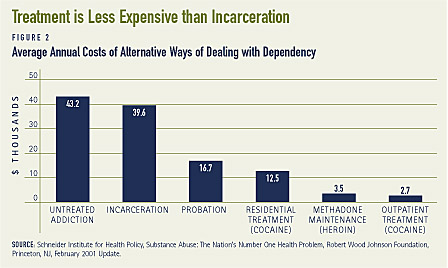Read more here.
Tag treatment
Mass Incarceration: Increases Crime, Destroys Lives
The idea is simple and seemingly a truism: round up all the bad guys, lock ‘em up, and crime will go down. The American criminal justice system has obviously bought into this idea: current incarceration rates show that 5% of the American population will have been imprisoned at some point in their lives (bjs.gov).
The problem with this logic, and the prevailing criminal justice system, is that it is a fallacy. Mass incarceration, unequivocally, DOES NOT decrease crime or recidivism. In fact, the opposite is true.
There are two main reasons why the “Lock ‘Em Up” approach is such a colossal failure. First, that mass incarceration does not act as an effective deterrent to crime, and second, that imprisonment ruins life prospects and therefore increases recidivism rates.
The majority of people do not need a major deterrent not to commit crimes. People are social animals, and the drives for acceptance and social acceptance (in addition to morals) are more than an adequate barrier to an outsider life of crime. However, the majority of people begin their criminal careers between the ages of 15-25, when they are most impulsive and don’t think in the long term. Even if getting caught and a harsh sentence are highly likely, the mind set is often “It won’t happen to me”.
This issue is compounded by the fact that getting caught isn’t necessarily certain and that sentencing length is all over the map- a landmark study by Michigan professor Mueller-Smith showed that sentencing was highly dependent on what judge gets your case or how busy the courts are in a given period (quartz.com).
The second reason may truly be the root of why mass incarceration is such a tragically flawed policy. It ruins lives. Socially, economically and spiritually.
Take the case of Jay* (name changed), whom I know personally. Jay was the All-American hero growing up: Eagle Scout, active in his church, Co-Captain of the football team, and joined the Army Reserves after graduating high school. An avid outdoorsman, Jay had his fair share of extreme sports injuries and ended up getting prescribed Oxycontin for a particularly bad shoulder injury. Within 6 months he was addicted, and ended up turning to heroin when the Oxycontin became too expensive.
Like most drug addicts, Jay ended up in jail because of his addiction. He had never stolen or become violent: he was arrested trying to shoot up in a bathroom at the mall where he worked. Jay describes what happened when he woke up from his drug detox in jail:
“I realized I had a felony now- I was a felon. I had lost my right to vote, lost my job, lost pretty much everything. I knew I could handle jail; it was what my life would be like after I got out that terrified me. Who hires a felon? Who marries a felon? I felt my life sucked away from me.”
Jay would be branded a felon for life- unable to vote, unlikely to secure a good job despite his college degree and military service, no help for his addiction and generally looked at as a second-class citizen. All for a non-violent drug offense. That’s the true tragedy and failure of mass incarceration.
Dollars & Sense: Rehabilitation Over Incarceration
Numbers don’t lie, as the old adage goes. So let’s take a look at some pertinent ones:
- 5 million people were arrested in 2013 for non-violent drug charges
- Close to 25% of those incarcerated (in all types of institutions) were non-violent drug offenders
- U.S. taxpayers spend approximately $17.5 billion a year incarcerating non-violent drug offenders (25% of the $70 billion incarceration bill the U.S. pays annually)
$17.5 billion spent on warehousing non-violent drug offenders- almost all of them drug addicts who would benefit from treatment and rehabilitation. That’s roughly $30-40,000 per inmate per year. With the average sentence length of a nonviolent drug conviction running 6 years, that’s $180,000. A drug addiction left untreated will result in continued drug use and arrests-which is why 63% of nonviolent drug offenders recidivate within 3 years. Recidivism costs the U.S. taxpayer more money re- incarcerating the same individual. The almost complete lack of any drug treatment available to inmates is a large reason for the astronomical recidivism rate.
Rehabilitation programs, which are the only realistic way to help and keep a drug addict from re-offending, cost drastically less than incarceration. The National Institute on Drug Abuse states that, “Treatment can cut drug use in half, decrease criminal activity, and reduce arrests”. Thirty day inpatient rehab programs can cost as little as $2,000, while outpatient programs are even lower cost (as little as $3,000 a year). Placing non-violent drug offenders in an inpatient or outpatient treatment program, combined with probation, is much cheaper to the taxpayer than incarceration. Economically, everyone benefits: less initial cost to the taxpayer, long term the offender is much less likely to re-offend, saving future incarceration costs, and the offender themselves can become a productive job-holding member of society.
Rehabilitating non-violent drug offenders is not just bleeding-heart, save the whales policy. It makes hard numerical sense. Completely objectively, would you rather spend $10,000 or $180,000? I would much rather spend $10,000. When a non-violent, drug addict receives proper treatment and probation, that individual is much more likely to:
- stop using drugs and spending thousands on their addiction
- less likely to reoffend
- get a job and pay taxes
An untreated drug addict will just continue to reoffend, costing the taxpayer more money indefinitely.
Sources: drugabuse.gov, drugwarfacts.org, http://www.cepr.net




